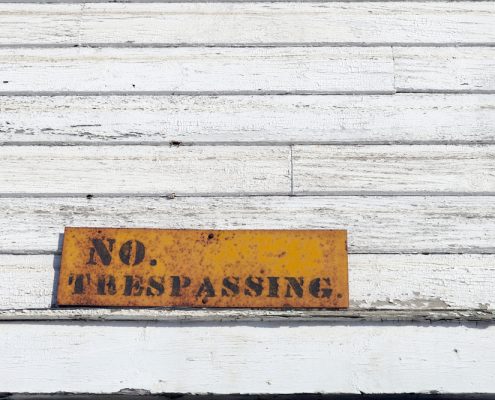
Historically, knowing how to effectively interrupt a claim of adverse possession was not well-settled. Do you post no trespassing notices, have an awkward or heated conversation with the neighbor, or engage in some questionable demolition? And would any of that even protect your property rights, legally? Thankfully, Wisconsin’s legislature recently provided property owners a much simpler solution. However, before getting into that solution, let’s briefly discuss the basics of how adverse possession works.
The Basic Components of Adverse Possession
In order to establish a claim to another’s property by adverse possession, a person must exercise control over another person’s property that is inconsistent/adverse with the property owner’s rights. The adverse use must be, as the courts have put it, “continuous, visible, open and notorious.” Generally speaking, to meet these requirements, there will need to be construction of a significant enclosure, cultivation of land, and/or some other improvement on the land (i.e. erection of a building, planting crops, landscaping, routine maintenance and upkeep, etc.) The pivotal component to adverse possession is time. The adverse use must persist for: a) 20 years if the adverse possession claim is not based on a written instrument; b) 10 years if the adverse possession claim is based on a written instrument – such as a deed; or c) 7 years if the adverse possession claim is based on a written instrument that is recorded with the register of deeds where the property is located and the adverse possessor can show payment of taxes associated with the property.
While at first glance these time periods might seem lengthy, do not let that lull you into procrastination if you discover someone adversely using your property. Adverse possession claims can accrue through successive ownership, meaning that an adverse possession claim could have begun accruing before you even acquired any interest in the land. For example, if you acquire an interest in a large tract of land that was not properly monitored by the prior owner, who allowed the adjoining property owner to – either wittingly or unwittingly – build a fence across the land 18 years ago, the adverse possession claim would fully accrue in two years. Your newly acquired ownership interest has no impact on the requisite time period. While ordering a survey prior to acquiring an interest in the land is good practice, there are various circumstances under which parties elect to forgo the costs of a pricey survey when transferring real estate.
Now, let’s say you’re the owner of a large plot of investment property in the north woods, and you just received an offer to purchase. The potential purchaser orders a survey, and upon inspecting the property, learns that the neighbor has been landscaping and maintaining a large portion of your lot abutting the neighbor’s property line. Although you’re a diligent property owner, this is investment property and you haven’t been to that portion of the lot in a few years. The question you’re now faced with is what to do to stop the adverse possession claim from accruing? In March of 2016, Wisconsin’s legislature provided us with an efficient and simple solution – the “affidavit of interruption.”
The Affidavit of Interruption
To be effective, the property owner simply records the affidavit of interruption along with a survey of the property that is no older than 5 years, and then serves a copy of those documents on the adverse user with a notice that the property owner intends to record the affidavit against the neighbor’s property as well. There are some specific requirements with regard to what needs to be included in the affidavit of interruption and the procedures for effectively serving notice on the adverse user, which are pretty straight forward and can be located in Wisconsin Statute Section 893.305(4) (google search that statute cite and it will take you right to it). When properly recorded and served, the affidavit of interruption “resets” the time period that is necessary to establish an adverse possession claim, which makes it an extremely efficient tool.
Of note, the affidavit of interruption will not defeat an adverse possession claim if the time period has already been established. This is one of the many reasons it is essential that you do not wait to exercise your rights and protect your property. Moreover, the affidavit of interruption is not the “be all, end all” for protecting your rights. It is one of the many options, and a very effective one at that, available to those looking to protect their property interests.
This document is intended for informational purposes only and is not legal advice or a substitute for consultation with a licensed legal professional in a particular case or circumstance.
If you need assistance with a related matter, contact us
